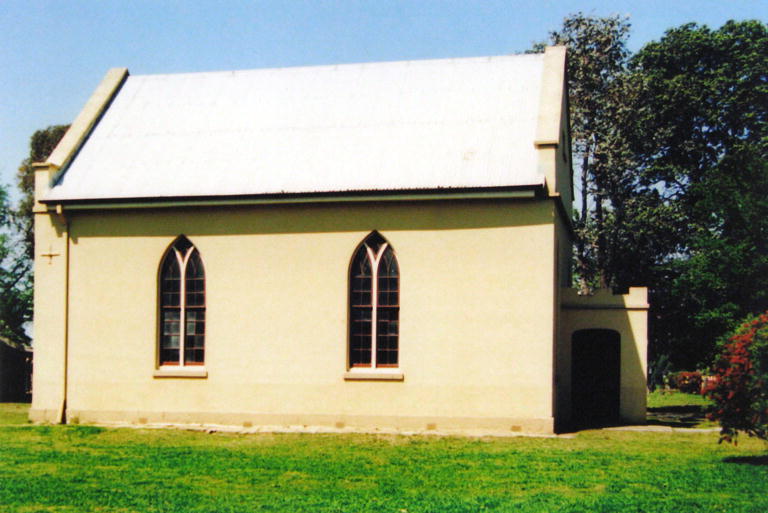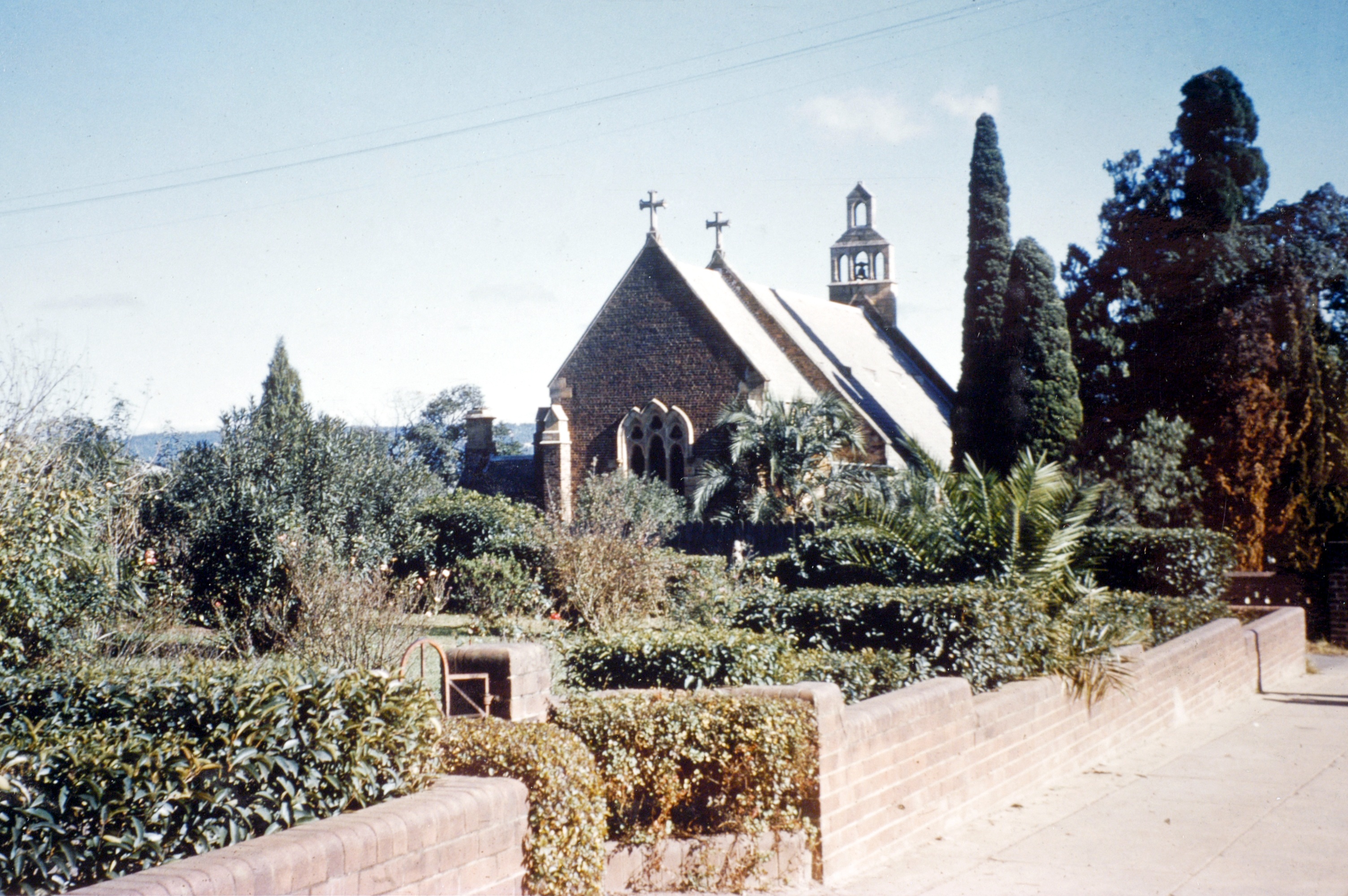Penrith City Local History - Buildings & bridges - Churches



Castlereagh Methodist Church – Castlereagh Road

Castlereagh Methodist Church, Old Castlereagh Road, Castlereagh (2009)
The original Methodist Church at Castlereagh is believed to be the first Methodist place of worship built in Australia. This first place of worship was a slab building attached to John Lee’s home. Later he built a weatherboard chapel – opened in October 1817 – and gave it to the Methodist Church. Lees was a former member of the N.S.W. Corps and had led a life “highlighted by drink and gambling”, until recovery from a snakebite precipitated his reform.
The present church was built in 1847 for £450. The old chapel became the Wesleyan Common School until the State Education System was instituted and a school built opposite the church. The church was on the Penrith Methodist Circuit.
In the later part of the nineteenth century the population of the Castlereagh region declined and there were no local trust members to maintain the church. As a result, the building became dilapidated until, in 1894, a trust was reorganised and the church was repaired and improved at a cost of £70.
In 1984 a permanent conservation order was placed on the church building. The church, church hall, and adjoining cemetery are already classified by the National Trust.
St Mary Magdalene Anglican Church, St Marys – Great Western Highway

St Mary Magdalene Anglican Church, Magdalene Street, St Marys (c1890s)
Phillip Parker King gave the land on which St. Mary Magdalene Church was to be built in a style similar to the St. Mary Magdalene Church in Dunheved, Cornwall, England, to a design drawn by architect Francis Clarke. The period between 1836 and 1850 marks the greatest church building period in the history of N.S.W. In 1837, Bishop Broughton reported that 82 additional churches were in the course of erection. The foundation stone to St. Mary’s was laid by the Bishop on 22 November, 1837, the same day as St. Stephens’ had begun in Penrith. The bricks for the church were made from the clay at the Dunheved estate, and the church was completed in 1840, when Bishop Broughton returned for the April consecration service. Unfortunately, the bricks have been cement-rendered and the slate roof replaced with tiles. Inside, the north wall bears a fine glass window to the memory of John King Lethbridge.
The cemetery has many impressive headstones marking the passing of important characters in Australian history; Phillip Parker King, Anna King, her daughter Mary, the King Lethbridge family and many other well known St. Marys family names; Hacketts, Charkers, Turners, Beacrofts.
St. Nicholas of Myra Catholic Church, Penrith

On 30 April, 1967, the present church of St. Nicholas of Myra was officially opened and blessed by Cardinal (Sir Norman) Gilroy. Designed by architect Brian Curtin, the contemporary design of the new church was a radical departure from traditional church architecture. With population figures climbing steadily in the Western suburbs in the early 1960’s, the new church of St. Nicholas of Myra was seen by the Catholic authorities as being better able to accommodate Penrith’s growing Catholic community. The new church not only offered increased accommodation, but the design of the church was seen to reflect the changing attitudes of the Australian Catholic Church in a modern age. Despite the obvious need for a larger Catholic Church in Penrith, many local residents were saddened by the demolition of the old church.
For many, the demolition of the old church severed a link with the past that extended as far back as the mid 1800’s.
The land on which the present church now stands was originally donated by John Tindale. Records suggest that Tindale’s offer was accepted by the Catholic Church in the late 1830’s. It is believed that the first services on the site were held in a slab building behind the present church in the 1840’s.

St. Nicholas of Myra Catholic Church, High Street, Penrith
By 1850, however, a more substantial building had been erected, the church being consecrated by Bishop Polding during November of that year. This church was to sever the Catholic community in Penrith until the erection of the present building in the late 1960’s. Even though relatively recent photographs of the building survive, many readers will not remember the building’s interior at all. In April 1909, an article appeared in Penrith’s local newspaper describing the church in some detail. The writer remarked that St. Nicholas “occupied one of the best positions in the town and is prettily situated amid shady trees”. The writer maintained that the building was “a good sample of church architecture, being more ornamental than many of the plain brick buildings” being built at the time. The windows were described as being “set in pairs” and were “well recessed, with a broad splay”. As for the church’s interior, it was observed that the “roof is vaulted, with exposed principals, the lining being old cedar. The choir are accommodated in a gallery at the western end”.
Sometime after the appointment of Father Barlow in 1891, the former church was renovated and partially restored.
The “unsightly” pillars were removed and a door was formed at the end of the nave. The old pulpit was replaced by a new portable one, while the roof was raised and the old choir gallery improved. Father Barlow also restored the original altar, removing a coat of thick whitewash from the original stones forming the altar frontal. The interior of the old church was also noted for its “splendid stations of the cross”, the pictures apparently adding a great deal to the aesthetic value of the old church’s interior.
Roman Catholic Presbytery: St. Nicholas of Myra Church, High Street, Penrith.
Although lacking the architectural interest and modern design of the relatively new St Nicholas of Myra Church (the old church being demolished and officially reopened on 30 April, 1967), the history of the old Catholic Presbytery nearby still deserves our attention.
When the foundation stone of the present presbytery was laid on Sunday, February 7, 1932, the local newspaper noted that the new building was to be erected “on the ground to the east of the present presbytery, which is very old and has outlived its usefulness”. Unfortunately, very little is known of this older presbytery, probably the first to be built in the grounds of the church. The ceremony of the setting and blessing of the foundation stone of the present presbytery was attended by the then Catholic Primate, Archbishop Kelly. He returned to Penrith later the same year when the presbytery was officially opened on Sunday, November 27, 1932. The ceremony was attended by many church and local dignitaries, the proceedings being watched by a “large gathering”. The building contractor was Mr J. Lampard, of Ashbury.
It is not certain when the first permanent presbytery was established in Penrith, although it is generally assumed that some sort of residence would have accommodated the priests when regular services began to be conducted on the present church site in the late 1830’s.
Before either of the two presbyteries were built in the grounds of St Nicholas’, the first Catholic priests that came to Penrith stayed with families at Cranebrook, usually the McCarthy’s. Penrith was originally included in the Windsor Parish, which extended east to the mouth of the Hawkesbury and included, among other places, Windsor, Richmond, Kurrajong and Penrith. The priests would come across from Windsor, stay at Cranebrook, celebrate the Mass in Penrith and eventually return to Windsor.
(Originally published in the Penrith District Star newspaper on 10 July, 1984 (p.21) – rewritten and updated with notes in January 1997.)
Notes: Information relating to the laying of the foundation stone and the official opening of the presbytery appear respectively in the Nepean Times newspaper on 13 February, 1932 (p.3) and 3 December, 1932 (p.3).
Website: http://www.stnicholasofmyra.org.au/
Church History: https://stnicholasofmyra.org.au/about-us/#history
St. Stephen the Martyr Anglican Church, High Street Penrith

St Stephen the Martyr Anglican Church, High Street, Penrith (1980s)
First Incumbent: The Rev. Henry Fulton was the first rector. He knew the area and its people well, as he had been a minister of the older area of Castlereagh just north of Penrith since 1814, and was also a magistrate of the court in Penrith.
A Local Landmark: The northwest corner of the Church’s thirteen metre tower was made Penrith’s trigonometric point and the tower became a landmark for travellers in the early days.
The Fabric: Built in local sun-dried brick, the exterior of the church began to crumble and was cement-rendered in 1906, both inside and out. Restoration and repairs have remained an on-going necessity.
The Interior: Originally, the pew settings were box type, rented as was the custom of the time, by various families. The box pews were removed and open long pews installed in the 1860’s. In 1952 the present arrangement of a centre aisle was effected. The bell, said to have been cast on the site, is dated 1838 and is still in use.
The Windows: The eastern window demonstrates the style produced in the 1870’s in N.S.W. and later ones present as pictures – those in the vestry depict the marriage in Cana and the 4 in the northern porch have caused it to be known as the Apostles’ Porch.
Rector: Rev. Tom Harricks
Associate Minister: Rev Mark Bolas
Postal Address: 252 High Street Penrith 2750 New South Wales Australia
Phone: (02) 4721 2124
Service Times: Sundays – 7:30 am | 10 am | 6:30 pm
St. Stephen’s Mission Statement:
At St Stephen’s we are a church that greatly values community and relationships of all ages. We meet regularly to get to know each other, encourage each other and seek to live out our faith in the life-changing Son of God – Jesus Christ
St. Stephen’s Anglican Church was the first Church built in Penrith and is now the 15th oldest surviving church in NSW. The foundation stone was laid on 22nd November, 1837, the local community contributing freely towards the cost of building the church.
The Site: The land on which the church stands was part of the original grant to John Best. Subsequently sold to John Tindale, this “one acre more or less”, which at the time was in the centre of the little village of Penrith, was obtained from John Tindale by the church for “£20 of lawful money”.
The Consecration: The Bishop of Australia, the Rt. Rev. William G. Broughton, consecrated St. Stephen’s Church on July 16th, 1839.
| Henry Fulton | 1838-1840 |
| Thomas Makinson | 1840-1841 |
| Robert Knox Sconce | 1842-1843 |
| Ben Lucas Watson | 1844-1853 |
| Elijah Smith | 1853-1868 |
| John Vaughan | 1868-1880 |
| George Brown | 1881-1899 |
| Edward Hargrave | 1899-1902 |
| Henry Holliday | 1903-1907 |
| Mervyn Archdall | 1908-1913 |
| Montague Hinsby | 1914-1920 |
| Leslie Hatfield-Fall | 1920-1924 |
| H. Norman Powys | 1924-1932 |
| John William Ferrier | 1932-1936 |
| Raymond Chapple | 1936-1947 |
| Archibald Hodgson | 1947-1960 |
| Richard Owen Dykes | 1960-1966 |
| Warron Bryden Brown | 1967-1984 |
| Donald Jesse Wilson | 1984-1993 |
| David Gray Mulready | 1993-2000 |
| Rick Miller | 2000-2013 |
| Tom Harricks | 2014-Present |
The Archives Office is located in the old rectory next door to the Church in High Street. The archivists are always keen to receive information about the parish, however trivial. Their aim is to index material so that it can be made available for interested persons and those conducting research.
The honorary archivists may be contacted through the Parish Office 9am-1pm, Monday to Friday or by telephoning (02) 4721 2124.
